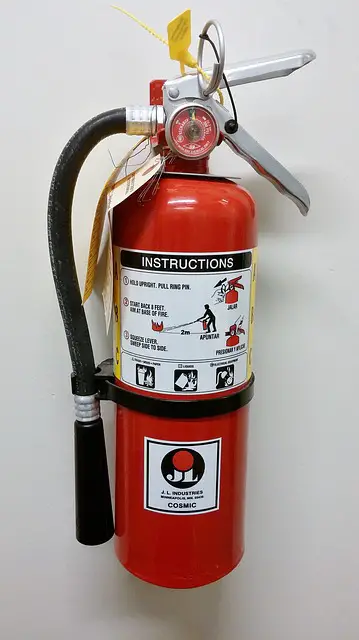Fire can cause the loss of lives, equipment, materials, and buildings—fire prevention is essential to everyone. To following, precautions should be observed at all times.
- Know the correct fire drills and the position of fire alarms, firefighting equipment, and emergency exits.
- Know the correct appliances to use for a particular type of fire and know how to use it.
- Do not block fire exits.
- Never smoke in “NO SMOKING” areas.
- Avoid spillage of flammable liquids.
The 3 factors are involved in starting a fire. They are,
Factors required for a fire
- Fuel (Combustible material, Combustion feeders, Flammable materials)
- 2. Heat (source of heat supply)
- 3. Oxygen
The involvement of these three factors is dearly illustrated by the fire triangular.

It is clear that the fuel (combustible materials) existing in 3 states. There are solids, liquids, and gases. By experience, we know that the flammable liquid (petrol) and flammable gases (LP) ignite in the presence of make flame easily. But it is difficult to ignite the solid combustible materials in the presence of make unless it exists in a tiny partner. Combustible material ignites in the presence of naked in or any other heat resources when these materials reach their flash point or ignition temperature, respectively.
Method of extinguishing a fire (fire prevention techniques)
Fires can be extinguished by removing one or two factors involved; basically, three methods are applied. (how to prevent fire from spreading)
- Starvation– By removing or limitation of the combustible materials.
- Smothering – By removing or limitation of Oxygen
- Cooling – By removing or limitation of heat
The other method is called chemical changes breaking reaction. By applying a chemical with an absolute velocity to the flame, then the flame’s change reaction can be demolished & the fire is extinguished.

Action In the event of the fire
Person detecting a fire
- An alert person nearby and request assister
- Call a fire service by pressing the nearest break blast or by telephone.
- Inform the fire board operator of the location of the fire.
- Operate first-aid firefighting equipment if safe to do so
- If the number of persons available in allowing initiate these activities simultaneously.
fire class types
Knowledge of these fire classes is required before extinguishing a fire.
[Red Color]- Class A
The fire involved in solids materials
Ex: wood, fabric, plastic, rubber, paper
[Yellow Color]- Class B
Flammable liquids and solids that become liquid during combustion.
Ex : Paint, Oil, petrol, Waxes, Liquor
(Extinguished with foam)
[Black Color]- Class C
Flammable gases
Ex: Petroleum, Acetylene, Gas, current, electronics
(Extinguished by CO2)
Class D
The fire involved in metals
Ex: Magnesium, sodium
(Extinguishing with dry chemical powder.)
Summary in tabular form

How to apply

how to apply
fire extinguishers
- Water- To be applied to the Heart of the fire.
- DCP (Dry chemical powder) – To be applied to the flame.
- Foam– To be applied to the Edges of the container or gently apply on the fire.
- CO2– To be applied to the fire by the Zigzag method
Ways to prevent a fire (when the wax dissolution ignites)
- Putting a wet sack or something
- Close with the pneumatic barrel or something
- Use fire extinguishers
- Remove the wax container and extinguish the fire airtight.


